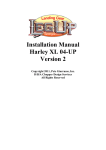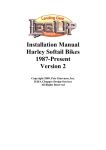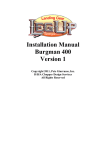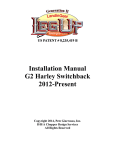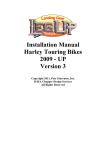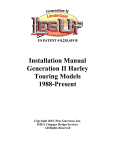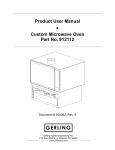Download Installation Manual Royalstar Venture 2006
Transcript
Installation Manual Royalstar Venture 2006-UP Version 2.1 Copyright 2012 Pete Giarrusso, Inc. D/B/A Chopper Design Services All Rights Reserved 2 Table of Contents INTRODUCTION .................................................................................... 4 WARRANTY ............................................................................................ 5 INSTALLATION INSTRUCTIONS ...................................................... 6 COMPONENTS: .................................................................................................... 6 1) 2) 3) 4) 5) 6) 7) 8) Control Switch Box...................................................................................................... 6 Linear Actuator ........................................................................................................... 6 On-board Computer Module ....................................................................................... 6 Proximity Sensor ......................................................................................................... 6 Leg Support Stand ....................................................................................................... 6 Leg/Wheel System ........................................................................................................ 6 Hardware Bag.............................................................................................................. 6 Actuator Bracket.......................................................................................................... 6 PREPARE FOR INSTALLATION ...................................................................... 7 INSTALL LEG SUPPORT STAND ..................................................................... 8 LEG SUPPORT STAND - ADDENDUM ............................................................. 10 ACTUATOR & BRACKET ................................................................................ 13 LEG/WHEEL ASSEMBLY ................................................................................ 15 MOUNT ACTUATOR LINKAGE ..................................................................... 16 CONTROL SWITCH BOX ................................................................................. 17 WIRING HARNESS ............................................................................................ 18 INITIAL SYSTEM TEST .................................................................................... 23 MOUNT PROXIMITY SENSOR ....................................................................... 24 FINISHING UP ...................................................................................................... 25 ACTUATOR ADJUSTMENT (Maintenance Mode) ....................................................... 26 TEST RIDE ........................................................................................................... 28 LEGUP LITE - ADDENDUM ............................................................................. 30 ILLUSTRATIONS ............................................................................................... 31 Wiring 1 ............................................................................................................................ 31 Wiring 2 ............................................................................................................................ 31 Wiring 3 ............................................................................................................................ 32 HARDWARE LIST .............................................................................................. 33 3 Introduction This manual covers installation of the LegUp Landingear system by Chopper Design Services. This system should only be installed by a qualified technician, or those with above average mechanical skills. If you are not SURE that you can perform this installation, please contact us and we will help you find a qualified shop to assist you. If you have been looking for a system that will keep your feet on the pegs, this is NOT the system for you! On the other hand, if a system that will relieve you of the weight of the bike and help you avoid balance problems as you approach a stop, LegUp is what you need. Improper installation will void your warranty, so please be very careful! Thanks for choosing LegUp! 4 Warranty Chopper Design Services warrants the LegUp system for a period of 1 year from date of purchase. This warranty covers replacement parts and/or manufacturer defects. Incidental damages or costs are the responsibility of the purchaser. Defective parts are to be returned to Chopper Design at the address below. Purchaser must contact Chopper Design to receive a Return Material Authorization, prior to returning defective parts to Chopper Design. Abuse, improper installation or use, collisions or accidents, are not covered under this warranty. Replacement parts for this type of damage are available through Chopper Design. Users of the LegUp system agree that Chopper Design is NOT responsible for personal injuries or damage to property arising from the use of the system. While we believe this system to be safe and reliable, the user is advised that use of LegUp is done so at the users’ own risk. Use of the system implies agreement to the above statements. If you can’t agree with the above, Chopper Design and its dealers would be happy to refund your full purchase price, before you use the LegUp System. Chopper Design Services 1365 Bennett Dr #101 Longwood, FL 32750 407-834-5007 [email protected] 5 Installation Instructions The LegUp® system has many components. Pleased be sure you have them all before starting your installation. COMPONENTS: 1) Control Switch Box 2) Linear Actuator 3) On-board Computer Module 4) Proximity Sensor 5) Leg Support Stand 6) Leg/Wheel System 7) Hardware Bag 8) Actuator Bracket If you believe you are missing any parts, please contact Chopper Design at 407-834-5007, and we will rectify the situation. Figure 1 6 PREPARE FOR INSTALLATION Place the motorcycle on an acceptable bike lift. You will need to keep the bike on its wheels for most of the installation, and jack the rear wheel off the lift for some portion of the installation. Make SURE the motorcycle is secure on the lift! Remove the seat and the right saddlebag; they won’t be needed until the installation is complete.. NOTE: The suspension on the RoyalStar is so soft, if the wheels are deployed with the rider’s weight on the seat, and the rider dismounts, the wheels will NOT be firm enough to hold up the bike!! Raise and lower the wheels with NO weight on the seat, and the legs will steady the bike adequately! Understand, LegUp was designed for riding. That fact that it holds the bike up without a rider is nice, but it is when a rider is on the bike that the system performs its’ function! We are now ready to begin! 7 INSTALL LEG SUPPORT STAND SEE ADDENDUM ON PAGE 10 BEFORE PROCEEDING! LegUp has developed a new, stronger attachment system which attaches to the RoyalStar® via two steel clamps that hold onto a round frame member below the bike and a strap that attaches in front to two mount points. Leg Support Stand Please find two ‘Mount Clamps’ (blue above). Note there is one for the right side and one for the left. Unscrew the recessed Allen bolt and the hex head nut to separate the clamp. Start on the left side. The horizontal strap is toward the back (the one shown here is the left side). Put a bit of Blue Loctite on the threads of both bolts. Take the clamp top and put it over the frame cross member, line up the bottom of the clamp, and start the Allen bolt in to tie them together; leave it a bit loose for now. Start the hex head bolt in as well. You have the correct clamp on the correct side if the flat 3/8” steel piece with two holes is facing the outside of the bike! 8 You will want to tighten the Allen Bolt until there is just a slight gap between the top and bottom clamp, on the rear side of this assembly. Make sure it is not so tight that you can’t move the clamp around. We do this because the Allen bolt will soon be covered and final tightening will occur using the hex head bolt! Again, MAKE sure the clamp can move, and then do the same on the right side of the bike! Once these are installed as shown, you can move onto the forward mount support. Find the ‘Forward Mount Support’. This is a thick piece of steel with two pieces welded to it with holes in it. The big hole goes toward the right side of the bike. Push this strap where the uprights go inside the frame tabs that stick down from the bike. Find two 3/8” X ¾” hex head bolts with lock washers, use some Loctite and start the bolts in from the outside to grab the threads on the uprights. You need to leave these loose for now. This would be a good time to check that the big hole is on the right side of the bike! If you haven’t done so already, remove the shaft from the mount plate (big plate with pipe on the end) by removing one of the chrome button head screws, and pushing the stainless shaft out of the plate (this makes it lighter). Find four 3/8 Cad bolts with lock washers (2 are ¾” long and 2 are 1” long), and holding the plate up to the clamps, start the outside screw (1”) into the clamps on both sides of the bike, leaving them loose for now. Use 3/4” screws for the inside holes and again, leave them loose for now. Make sure; long bolts are outside and the short bolts are inside! 9 LEG SUPPORT STAND - ADDENDUM We have made an addition to help the actuator linkage from flexing. This is a strap that bolts to the bottom right side of the plate we reference above. We have included one bolt that is 1 ¼” long, and the other is 1/18” long (which needs to go toward the inside). Any Questions please call us at 407-834-5007. 10 The next step is to find the ‘Forward Support Straps’. These are thin steel with a slot on one side and a hole on the other, with a small square welded to the bottom to locate the plates. With the slot toward the back of the bike, start a 5/16-18 screw with flat & lock washer through the slotted side first and into the threads in the plate. Using a bolt and just a lock washer, start the threads into the ‘Forward Mount Support’. The one on the left will be removed later, so just barely start each bolt (these straps line up the assembly). Do the same for the right side, but you can and SHOULD tighten both bolts on the right side.. We would like to tighten the 3/8” bolt that holds the ‘Forward Mount Support’ to the bike. Starting on the right side, make sure the strap you just installed is tight, then using a ratchet, tighten the 3/8” bolt as shown here (left). Moving to the left side, you will see that the bolts that holds the strap makes it impossible to tighten the Mount Support! No worries mate! Now that the left side is tight, the assembly is lined up where it needs to be. You can remove the forward bolt from the left side strap, swing it out of the way, tighten the bolt to the ‘Mount Support’, reinstall the bolt to the strap and tighten both bolts all the way down! Now would be a good time to make sure that the spacers under these straps rest against the big plate and the forward support. 11 Now we can tighten all the remaining bolts under here in order. First, make sure that the forward bolts and straps are very tight. This strap setup is what lines up the entire support system. Next the four bolts that hold the clamps to the plate get tightened. Finally, the hex head bolts on the bottom of the clamps get tightened. As shown here, clearance to tighten these bolts is built into the clamp bottom. Once all of the bolts are tight, grab the support plate and give it a tug! It should be one with the motorcycle. We can now move on to mounting the actuator and its bracket! 12 ACTUATOR & BRACKET Unlike any other LegUp installation, the actuator and bracket mounts to the vehicle horizontally. There was no room on this bike to mount it vertically, so we mount it below and behind the right front floorboard on the bike. As you can see in the drawing, the actuator and its mount is an intricate piece. There is an aluminum coupler at the end of the shaft, a sleeve that mounts to the ‘Forward Mount Support’ to keep the actuator in line, and an attachment point with dirt shield that attaches under the floorboard. This assembly should be together when you receive the kit. First, remove the rear bolt from the right-side floorboard bracket. Then take the Actuator/Bracket assembly; put it up to the bike with the sleeve resting on the ‘Forward Mount Support’. Line up the hole in the support and start the 7/16-14 X 1” Bolt up through the support into the threads in the sleeve on the actuator. Some Loctite on the bolt here, but leave the bolt loose for now, the actuator and bracket should be supported now as shown below. If the holes don’t line up, loosen the two small Allen Heads on the silver clamp on the actuator and slide the clamp to where it does line up. Make sure to retighten the Allen Heads) 13 Find the M10 X 60MM bolt that will support the front of the actuator bracket. This bolt is threaded through the front hole in the actuator bracket, then the spacer and back into the frame where the bolt was removed earlier. Tighten this bolt (Loctite please!) most of the way, but go back and tighten the bolt you threaded into the actuator sleeve before final tightening this forward bolt. The actuator should be very tight to the bike at this point. When this is all completed, the actuator and bracket assembly should look like the picture below. Now let’s install the Leg/Wheel Assembly! 14 LEG/WHEEL ASSEMBLY In the event you didn’t do this before, remove the bolts from the stainless steel rod in preparation for mounting the legs. With help from an assistant, slide the Leg/Wheel Assembly around the rear tire (careful of the finish!), and align the Leg Mounting Points with the slots in the Support Stand. If available a very small amount of ‘Never Seize’ on the shaft is in order here. Then start the stainless steel shaft in from one side through the tube on the support stand, and through the first leg mounting point and its bushing. The fit is tight, so take your time. Carefully work the shaft through the tube and the second leg mounting point. The shaft is inserted properly when it is inserted just past (approximately 1/8”) the end of the tube. This distance should be about the same on both sides, but it is not critical as long as both sides are inside the tube. If you need to, you can tap lightly on the shaft (brass drift or dead blow hammer is preferred here). Once the shaft is in place, use a small amount of blue thread locker and install the (2) chrome bolts and washers on the end of the shaft to finish it off. Make sure the legs move up and down without any binding! 15 MOUNT ACTUATOR LINKAGE Now we need to tie together the actuator and the wheel/leg system. Find the actuator linkage, a 3/8” piece of steel (shown at right, may be 2 3/16” pieces, treat them as one), and find the 5/16” X 1.5” Bolt and the 5/16” lock nut. The linkage should be oriented with the long piece toward the back and up. Slide the bracket(s) into the rear actuator mount on the legs, and insert the bolt through the mount and the linkage. Install the lock nut behind and tighten it. Be careful not to over tighten this bolt as it will pull the arms of the rear mount together. As long as it is snug and you have grabbed the nylon on the locking nut, it is tight enough. In order to mount the front of this linkage you may need a helper. The idea is to line up the front hole with the coupler on the actuator, insert another 5/16 X 1.5” bolt (with Loctite) through the coupler, the linkage, and threaded into the back side of the coupler. DO NOT OVERTIGHTEN! You may have to have someone hold the bottom of the legs up to line this up or you may have to lengthen the actuator to get the two pieces to align. NOTE: If the actuator is too short to reach the other mount you may have to lengthen it using the system. Temporarily install the wiring harness to the bike (as described in the Wire Harness Section), and follow the directions for ‘Maintenance Mode’ in the ‘Initial System Test’ section below. Using what would be the left button on the switch box, just add a small amount of length to the actuator so you can align the mounts, then turn the bike back off. 16 CONTROL SWITCH BOX The switch box should already be mounted to a black mounting plate. The switch box mounts under the left mirror. First dismantle the plug, so you can run the wires where they need to go. Next, remove the left mirror, and the adapter. Slide the adapter through the hole on the switchbox, and with some Loctite, tighten the adapter back down to the hand control. Make sure the switchbox is square to the bike before final tightening. You can then reinstall the mirror. You will need to run the wire over the clutch perch, down the handlebar, over the top of the triple-tree, then back under the edge of the tank to end up under the seat area. We removed the bottom clip that holds the plastic cover in front of the tank, so we could slide the wire from under the bars, under the plastic before running it under the tank. You need to make sure you have enough slack to put the plug back on, after the wire is under the seat area! Reassemble the 8-pin connector using the diagram at the top of the page, making sure that the colors match perfectly. Sometimes it is smart to plug the harness in to verify perfect reassembly. Now onto the rest of the wiring harness! 17 WIRING HARNESS NOTE: If you have a LITE System, Please refer to the addendum at the end of this manual, for differences between a Regular and LITE Harness! The next step is to route the wiring harness. The harness and the plugs are routed mostly under the seat and right saddlebag. First we need to make a small notch in the right saddlebag to allow the wire for the computer to enter the bag without being crushed. We used a rotary tool, but a round file or small saw would work as well. The notch is positioned as seen in the photo. It is approximately 3/8” wide and just over 3/4” long. Notice that it extends just below the lip that the top cover mates to. This is very important! Otherwise the lid would crush the wire. It goes without saying that this notch in on the inside, or back-side of the bag. Set the bag aside as we won’t need this until the very end. We will start by running the wires for the actuator. Remove the 6position plug from the actuator wire. Remove the right side cover. The wires should already be tied to the bracket bringing it inside of the exhaust pipe. We need to run this wire along the frame rail behind the pipe (use wire ties to guide it), then behind the horn, up under the side cover area, and into the under-seat area. See the picture on the next page. 18 Here you can see that we ran the wire safely behind the pipe, and we snake it in next to the white plastic reservoir that is hidden under the side cover. From here we want to run the wire carefully up under the seat. The picture below shows it exiting in this area. Double check the wire from the actuator all the way back and make sure it won’t touch anything hot, or that be hit by anything that moves (like the brake linkage). If you are happy with the wire routing here, reassemble the plug carefully (plug wire positions are found at the end of this manual). We will now move onto the main harness. 19 Find the proximity sensor (little yellow square on a bracket with a long thin wire with a three pin plug attached). Put the sensor and bracket near the rear brake, and run the wires up to the seat area. We ran the wire along the swing arm and it will be tied along the brake line later. Leave a bit of slack as you aim the wire up to the right side of the battery under the seat. Get the wire up there and reassemble the plug. This is a three position plug, so it is VERY easy to wire incorrectly. Refer to the diagram here and take note that the wires are on the sensor side. It may be easier to plug this into its mating plug to verify the colors. NOTE: We will mount this bracket in this area later, but making sure you have enough wire to mount it and that the extra slack is pulled to the under seat area! Now find the main harness and the 12 position plug on it. Disassemble this plug so we can route it from the seat area, back to the right saddlebag. Use some electrical tape to tie all the silver ends together to make this easier. We removed the Phillips-head screw on the plastic cover shown here to make the wire routing easier. The cover will not come off, but it will allow access behind it. Start the wire down past the right side of the battery (near the proximity wire you just ran), under the frame pieces you will find there, and back up to the spot shown here. Notice that we pulled the wire until it reached the hand rail. This is the approximate amount of slack that will allow us to tie the wire off neatly, and go into the saddlebag for the computer. Reassemble the 12 pin plug according to the diagram at the end of the manual. The remainder of the harness can be placed in the under seat area, and all the mating plugs, snapped together for now. 20 The next step is for us to get the power connections to the bike. Find the white plug under the seat. We need to install the purple plugs over two of the wires attached to the plug. Wrap one of these snaptogether connectors around the blue wire, and another around the black. These connectors will snap closed and become a spade connector we attach our power leads to. On the harness, you will find two red plugs; one is attached to an orange wire and the other to a black wire. Carefully plug the orange wire on the connector attached to the blue wire, and the black one on the black wire from the bike. Make sure you don’t have these backwards! Make sure you have attached all mating plugs (they can’t be attached improperly) together. You should have a 3 place plug from the proximity sensor, an eight place plug from the handlebar switch and a 6 place plug from the actuator. No need to neaten them right this minute, but the picture on the next page shows them all tied up nicely under the seat. Attach the computer to the plug near the saddlebag area and let it dangle for now. We want to test the system, and then we will do final wire tie down and attach the computer to the saddlebag. Placement of the computer in the saddlebag, and a good look at the wires tied down neatly can be seen on the next page. 21 Under Seat Wire & Plug Layout Attach Velcro inside Saddlebag for the Computer Mount Computer as shown. 22 INITIAL SYSTEM TEST NOTE: If you have a LITE System, Please refer to the addendum at the end of this manual, for differences between a Regular and LITE system. Skip this section if you have a LITE System. Turn your bike on. At this point, have a look at the yellow proximity sensor. The LED Should Not Be Lit. Take a metal object (screwdriver, wrench, etc) and hold it on the flat face of the sensor (it has a circle embossed in it). The LED should light up, and go out when you move the metal away. If not, check all your connections. Next, press the rightmost pushbutton and hold it for at least 3 seconds. One or both LEDs on the switch panel should light up; we really don’t care which at this point. If this occurs, you are doing well. If both LEDs are flashing (maintenance mode) you can skip the next step which is to press both buttons until both LEDs flash. Next press both buttons for just an instant! If everything is working, the bottom or yellow LED on the switch box should flash, and the top LED should be out. The next step, and be careful here, is to touch the left button for a split second. The legs should move down just a bit. Touch the right button, and they should move up. With the bike on the lift, you have to be very careful here! If all of the above has occurred, raise the legs. Press and hold the right button until it stops, and turn the ignition switch off! The test is now complete. Let’s move on to mounting the Proximity Sensor. 23 MOUNT PROXIMITY SENSOR NOTE: If you have a LITE System, Please refer to the addendum at the end of this manual, for differences between a Regular and LITE system. Skip this section if you have a LITE System. This step is crucial!! Understand it before starting. The proximity sensor tells the system how fast the bike is traveling. The proximity sensor mounts to the bolt that attaches the rear brake to its mount. Remove this bolt, install it through the bracket and reinstall the bolt semi-tight, so the bracket can be moved if need be (a little Locktite please!). You need to jack up the back wheel or have the bike on the ground so we can spin the wheel to test the sensor and its placement. Make sure the bike is in neutral. The sensor will track the rotor bolts on the rear wheel as it spins, and is to be mounted 5MM away from the bolts or closer. Look at the picture here. Once the bracket is mounted, turn the key to the ‘ON’ position, spin the wheel or roll the bike and watch the behavior of the sensor as the bolts pass it. The LED on the sensor should be off when no bolt is passing the sensor, and the LED should light when a bolt passes by the sensor. Play with this by rotating the wheel back and forth while adjusting the bracket in, out, left or right until the light blinks consistently. Once you feel you have the right place, tighten the bracket down and slowly rotate the wheel. Every time a bolt passes, the light should get bright when the bolt is nearby and off after it passes. If this is not happening, you may need to get the sensor a bit closer to the bolts (5MM is a very small distance!). If you have to move the sensor closer, just loosen the bolt again, and re-adjust the sensor. No matter what you need to do, you MUST make sure that as the wheel turns, the light works as described above! Once you are certain, tighten the bracket down very firmly! Re-check that everything functions properly by spinning the wheel past all 6 rotor bolts and 24 verifying that the LEDS changes as described above. The automatic retraction of the legs as well as their deployment RELIES on this sensor being placed perfectly! Once satisfied with the mount, make sure the wire that runs down the brake line, along the swing arm, up to the seat area, is tied off, clears everything, and can’t get damaged by anything. 25 FINISHING UP Now it is time to reinstall all the covers and extra pieces that were removed to allow the installation. Get that saddlebag back on, mount the computer with Velcro, and reinstall anything else you took off. Make sure that everything is clear. This would be a great time to double check all the bolts and see to it that none of the wires are in any kind of distress! Once you are comfortable that everything is correct, get the bike off the lift so you can dial in the actuator, and adjust the wheels. ACTUATOR ADJUSTMENT (Maintenance Mode) NOTE: If you have a LITE System, Please refer to the addendum at the end of this manual, for differences between a Regular and LITE system. Skip this section if you have a LITE System. Once you have the bike on the ground, turn the ignition on and start the LegUp System (hold right button for 3 seconds). The system should enter maintenance mode automatically (Both LEDs Flash), but if it does not, enter maintenance mode manually (Both buttons for 3 seconds). With a helper nearby, straddle the bike, and hold it level. Hit both buttons for an instant to get the system in the “DOWN” setting mode (yellow LED flashing). Straddle the bike so your weight is NOT on the seat, hit and hold the left button until the wheels contact the ground and stop. Make sure that the suspension raises a bit as you do this. If not, the legs are not going down far enough, the bottom actuator mount may need to be moved left or right a bit to get the wheels all the way down (Contact LegUp for assistance if you need help with this). Once these wheels are down as described above, try to put both feet on the floorboards. The bike should be reasonably stable and you should be able to lean a bit in both directions without the bike falling over. The DOWN stop is now set! Hit both buttons for a moment to get into the “UP” stop mode (top LED blinking). Carefully use the right button to raise the legs. Have your helper let you know as you approach anything that may come in contact with the wheels or the legs. You also need to make sure the system clears pipes, clamps etc. If you can’t make the clearance to allow the legs to come up all the way, you can set the up stop just below whatever is interfering (if not, you will likely set up a permanent rattle!) Hit both buttons when complete, and you will be done with these adjustment. 26 Now press the left button and the legs should lower. Hit it again and the legs should retract. If you are satisfied with these limits, you have successfully installed the LegUp System. Time for a test ride! 27 TEST RIDE NOTE: If you have a LITE System, Please refer to the addendum at the end of this manual, for differences between a Regular and LITE system. Deployment and Retraction of the wheels is COMPLETELY MANUAL if you have a LITE System. Get the bike to a clear paved mostly level area where you can test ride it. Start the bike, turn on the LegUp system and lower the legs. The first test should be done in a straight line. Put the bike in gear and slowly accelerate. You may notice that the bike tends to want to steer a small amount left or right. This is normal unless it is severe. Once underway, the top LED should flash at around 6 MPH, meaning the legs are retracting. You can lean on one wheel or the other as you leave to reduce any darting the system may be giving you. Assuming the legs are retracted, you should try to deploy the wheels. As you come to a stop, the Green LED should be on. As you slow down (almost stopped), the Yellow LED should illuminate at the proper speed. Once it does (sometimes hard to see), hit the left button and put your feet down near the ground. The top LED should flash and you should soon feel the wheels deploying underneath you! Make sure you are ready to balance the bike! Uneven ground or lack of familiarity could make the bike want to lean one way or the other. With your feet ready to balance the bike, this should be no big deal. The slower you are going when deploying the wheels, the smoother the transition will be from wheels up to wheels down. Practice these maneuvers until you are comfortable with the wheel adjustments and the system operation. SEMI-AUTOMATIC DEPLOYMENT: Another way to deploy the legs is to hit the left button while you are running at any speed over 10MPH with the wheels up. The bottom or yellow LED should start to flash. When you slow down to around 8MPH the wheels will start to deploy (see the red/green flash on top LED). Again prepare to put your feet down. NOTE: The bottom LED Should not be LIT if the legs are up over 10MPH! In the event it is, the wheels will deploy instantly if you try to set them as above; this is dangerous! You MUST re-visit the sections on testing the proximity sensor. You should always be aware that this light should NOT be on if you are traveling at speed, and ‘Arming’ the system for deployment should only be attempted if the lower LED is Not Lit! Please see the User Manual for more information on Proximity Sensor Failure! 28 The next thing to try is to make a turn right after a dead stop with the wheels down. As soon as you start the bike moving, try a left or right turn immediately by leaning into that turn. You may find that you have to nudge the bike a little bit more than usual to get the bike to lean, and you won’t be able to lean as far as you can with the wheels up. Once into the turn, accelerating will raise the wheels. You will hardly notice the wheels coming up unless you see the top LED blinking! The next thing to try is slow speed maneuvering with the wheels lowered. In a straight line on level ground, you should be able to keep your feet on the floorboards and move the bike forward at very slow speeds (simulate stop and go traffic). I like keeping my feet near the ground during these maneuvers! You can also try small ‘Trike’ turns; keeping the bike upright at slow speed and making turns as you would in a parking lot. Be aware that if you get over the speed that the legs come up, they will!!! Another thing I like to do is donuts. Start out slow, lean the bike left or right, and make circles at very slow speeds (throttle on, rear brake on, clutch slipping… you know like the cops do!). This helps you get familiar with the wheels being on the springs and allowing a lean angle! Practice, practice, practice!! Enjoy your LegUp System! 29 LEGUP LITE - ADDENDUM If you have a Lite System, there are a few differences in the wiring compared to our Regular system. The plugs and their locations don’t change at all! Instead of plugging in the computer to the twelve pin plug, the Relay-Pack gets plugged into this plug. The Relay-Pack will be attached with Velcro as the computer would have been in the same location. On the LITE system there is no proximity sensor, so ignore the testing and mounting of this sensor, and realize that the three pin plug will be left without a mating connector. We keep this plug in the wiring harness in case you upgrade to a regular system in the future. Using Your Lite System: Unlike our Regular System, you don’t turn the LITE system on, or adjust the legs as described in the ‘Maintenance Mode’ section of the manual. When you turn your bike on, the LITE system is ready to go! Press and hold the left button to lower the wheels, press and hold the right button to raise them. No lights will flash; it is up to you to control the system manually! Please use EXTREME Caution when using the LITE System! Keeping the wheels lowered at speeds over 9MPH can be dangerous. Since the system is manual, please don’t allow its’ operation to distract you from controlling the vehicle! Upgrading you LITE System: If you have a LITE System and have chosen to upgrade it to the regular system, there are just a few things you need to do. Unplug the Relay-Pack, and plug the computer in where the RelayPack was attached. Run the wire for the proximity bracket and plug it in, test it, and mount it, as described in the ‘MOUNT PROXIMITY SWITCH’ section of this manual. Once the new pieces are attached and plugged in, refer to ‘ACTUATOR ADJUSTMENT (Maintenance Mode)’, earlier in this manual to set the lower and upper stops for the computer. That’s all it takes! 30 ILLUSTRATIONS Wiring 1 There are three different types of actuators with three different wiring configurations. Refer to the notes at the bottom of the pictures above so you can match your actuator with its wiring scheme! Wiring 2 31 Wiring 3 32 HARDWARE LIST (2) 3/8-16 X 2.25” Chrome Allen Bolts (Rear Clamp) (2) 3/8-16 X 2.00” Cad hex Bolts (Rear Clamp) (1) 3/8-16 X .75” Cad Hex Bolts with Split Washers (Left Rear Clamp to Plate, Inner) (1) 3/8-16 X 1.00” Cad Hex Bolts with Split Washers (Left Rear Clamp to Plate, Outer) (1) 3/8-16 X 1.125” Cad Hex Bolts with Split Washers (Right Rear Clamp to Plate, Inner) (1) 3/8-16 X 1.25” Cad Hex Bolts with Split Washers (Right Rear Clamp to Plate, Outer) (2) 3/8-16 X .75” Cad hex Bolts with Split Washer (Forward Support Strap to Bike) (2) 5/16-18 X .75” Cad Hex Bolts with Flat & Split Washers (Forward Straps Rear Bolts) (2) 5/16-18 X .75” Cad Hex Bolts with Split Washers (Forward Straps Forward Bolts) (1) 1/4 - 20 X 1.25” Cad Hex Bolt (Actuator head to mount bracket) (1) 1/4 - 20X 1.75”Chrome Allen Bolt with Lock Nut (Actuator Shaft to Coupler) (1) 5/16 - 18X 1.50”Chrome Allen Bolt (Coupler to Actuator Linkage) (1) 5/16 - 18 X 1.5” Chrome Allen Bolts and Lock Nut (Linkage to Rear Mount) (2) 5/16 - 18 X 1.25” Chrome Hex Bolts with Split Washers (Rear Mount to Legs) (1) 7/16 – 14 X 1” Chrome Allen (Actuator Sleeve to Front Mount) (1) SPACER: .55”OD X .395”ID X .44” Long (Actuator Mount to Bike) (1) M10 X 60MM Hex Head Bolt (Actuator Mount to Bike) (1) 10-32 Allen Head Bolt cut to 1.3” (Handlebar Box) Hardware Bag with ties, Rubber bumper installed on plate, etc. 33



































